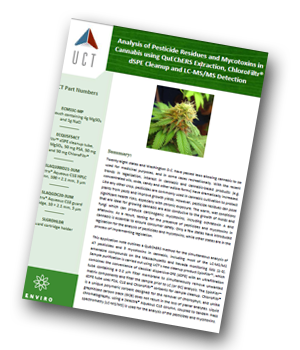UCT has produced an application note describing the simultaneous analysis of pesticide residues and mycotoxins in cannabis using QuEChERS extraction.
 Introduction
Introduction
With the recent trends in legalization, interest in cannabis and cannabis-based products (e.g. concentrated oils, soda, candy and other edible forms) have dramatically increased. Pesticides are commonly used in cannabis cultivation to protect plants from pests and improve growth yields. However, pesticide residues can pose significant health risks, especially with chronic exposure.
This application note outlines a QuEChERS method for the simultaneous analysis of 47 pesticides and 5 mycotoxins in cannabis, including most of the LC-MS/MS amenable compounds on the Massachusetts and Nevada monitoring lists. Sample purification is carried out using SpinFiltr™, combining the convenience of classical dispersive-SPE with an ultrafiltration tube containing a 0.2 μm filter membrane to simultaneously remove unwanted matrix components and filter the sample prior to LC (or GC) analysis.
Discussion
Sample preparation was carried out using a QuEChERS-based approach. Acetonitrile containing 2% formic acid and unbuffered QuEChERS salts were used in the extraction step to prevent the acidic ochratoxin A from being retained on the PSA sorbent during dSPE cleanup, although this also contributed to reduced recovery of pymetrozine (a basic analyte). The use of higher pH extraction conditions, including the use of citrate and acetate buffered QuEChERS salts, resulted in lower recovery of ochratoxin A. The use of ChloroFiltr®, a novel polymeric-based sorbent designed for the selective removal of chlorophyll, was effective in removing pigments without sacrificing recovery of planar analytes.
Furthermore, by using UCT’s SpinFiltr™ product, valuable time was saved during the dSPE cleanup step as the sample extract is purified and filtered simultaneously by the built-in 0.2 μm PTFE filter membrane. Cumulatively, this saves valuable time and cost while providing improved robustness and less instrument downtime. In addition, a larger sample volume can be recovered (≥ 90%) compared to classical dSPE and the tedious pipetting step and the associated risk of sorbent carryover is eliminated.
Conclusion
The method outlined in this application note allows for the simultaneous analysis of 47 pesticides, 5 mycotoxins and potency in cannabis in one simple QuEChERS extraction procedure, thereby saving time, sample and cost. Analysis of the samples was performed by LC-MS/MS using a Selectra® Aqueous C18 HPLC column, which allowed for improved retention of the more polar pesticides included in the method. The method was evaluated by fortifying cannabis samples with each compound at four varying concentrations (n = 4 each). The average recovery obtained was predominantly in the range of 70-100% and the reproducibility ≤10%. With the widespread legalization of cannabis, this simple method will be beneficial for any research facility wanting to implement regulatory testing.




